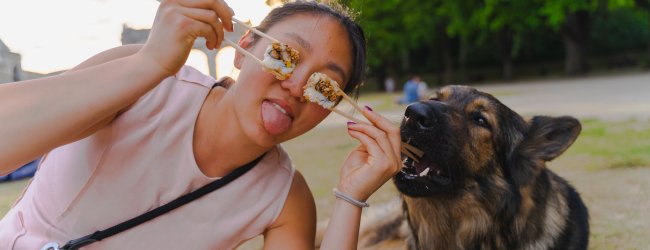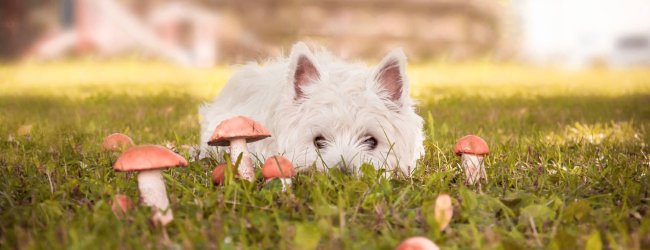How Much Should I Feed My Dog? (And How Often?)
Feeding your dog might be a challenge, if you're not familiar with the individual needs of your furry friend. So here are tips on how much & how often you should feed your canine buddy - and how to prevent them from scavenging outdoors.
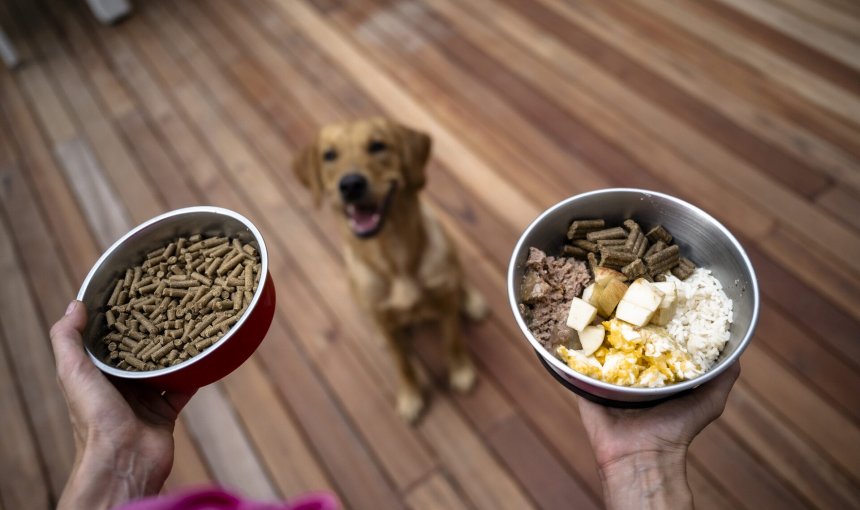
Wandering down the grocery aisle, you might’ve seen the endless shelves full of the different kinds of dog food and pet nutrition brands. Meaning nope, you wouldn’t be the first to wonder, how much should I feed my dog? And how often?
Because as it turns out, feeding your buddy the right amount can make all the difference in:
- Keeping them at a healthy weight
- Preventing them from gaining weight – and developing any weight-related health problems down the line
- Deterring them from scavenging for any extra “treats” and nibbles outdoors
So in this post, we’re going to cover the essentials for feeding your dog – including the best way to prevent them from scavenging or begging for food from strangers. Let’s go!
How much food should I feed my dog? What to consider before serving
Now you might’ve noticed a recommended serving size on dog food cans and labels. But as it turns out, the right amount of food for your buddy depends on their:
- Size and weight, with larger breeds needing more food than smaller breeds.
- Age, with puppies needing more frequent meals compared to adult dogs.
- Activity level, since active dogs burn more calories than more sedentary dogs – and need more food.
- Health condition, especially if your buddy is on the overweight side. Dogs with health issues or those on weight loss programs may need special, vet-approved diets.
- Whether they’re neutered or not, with neutered dogs needing slightly fewer calories than intact ones.
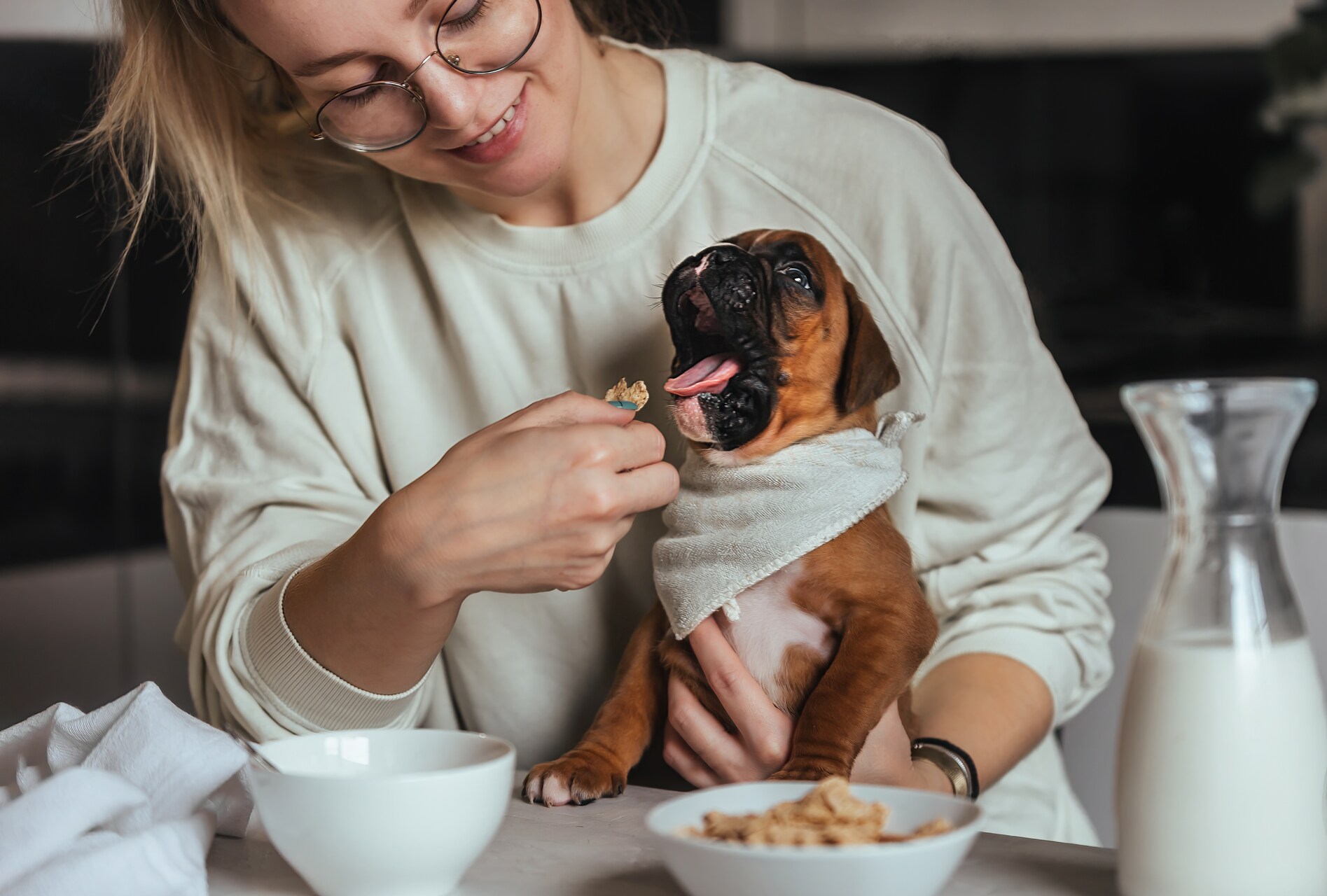
Your vet is the best guide to figuring out exactly how much to feed your dog, based on your buddy’s individual needs. But here’s a super general guide for adult dogs based on their weight:1
| How much your dog weighs | Recommended food serving |
| 3-6 lbs | 1/3 to 1/2 cup of food per serving |
| 10-20 lbs | 3/4 to 11/3 cup of food per serving |
| 30-50 lbs | 13/4 to 22/3 cup of food per serving |
| 60-100 lbs | 3 to 41/2 cup of food per serving |
| 100+ lbs | 41/2 plus 1/4 cup for every extra 10 lbs |
⚠️ Again, these are super general guidelines. Depending on your dog’s weight, size, and activity level, you should adjust their intake to prevent them from over- or under-eating.
- A dog that’s overweight, neutered, or on the older side should eat slightly less than the recommended serving size on any food package.2
- On the other hand, a puppy, intact dog, or a highly active one might need slightly more.
It’s also a good idea to weigh your dog’s food before serving, so you’re not over- or under-feeding them. (Which can lead to them either gaining weight – or sneaking outdoors to scavenge for some extra snacks!)
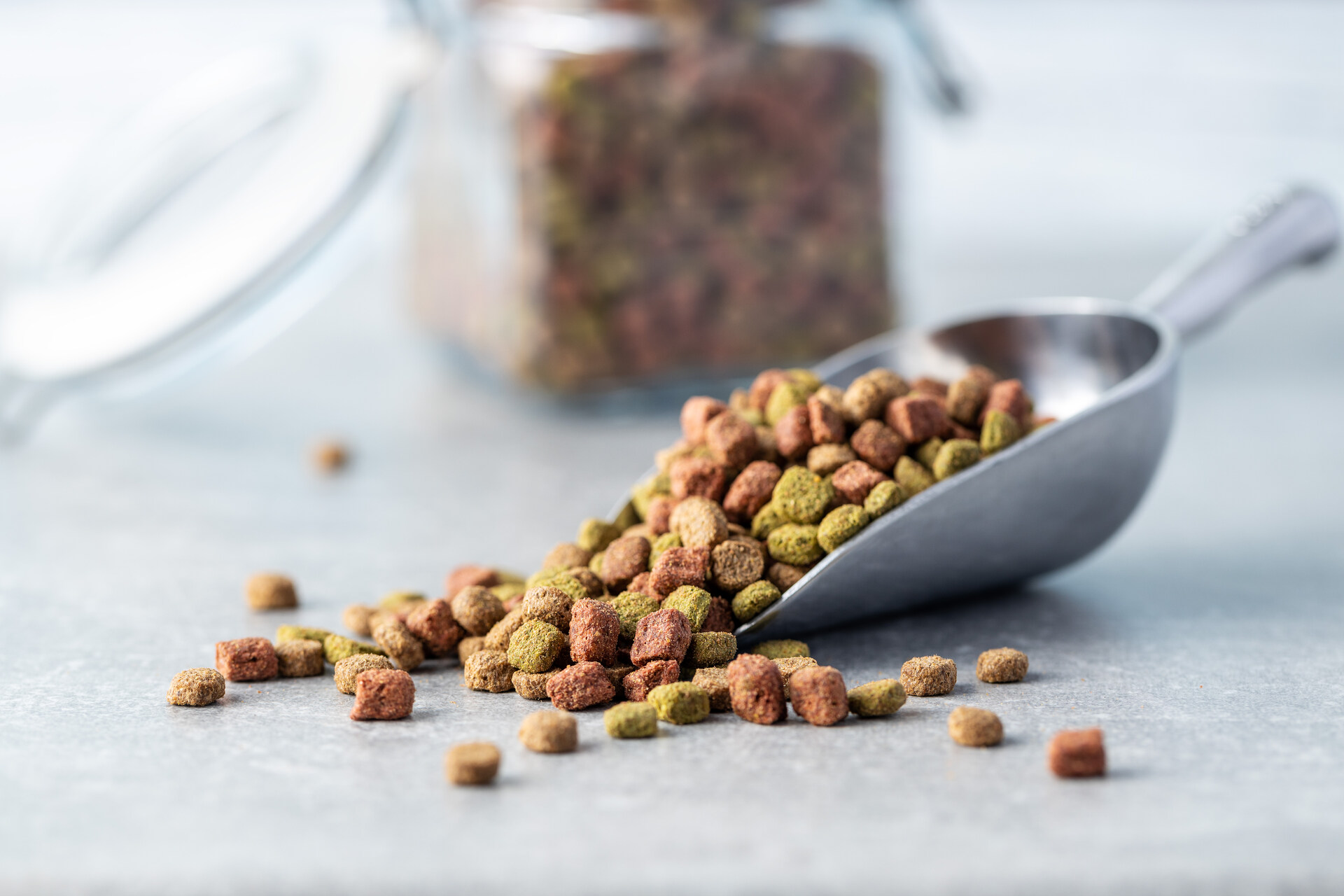
Where your dog’s body condition score plays a role & how to figure it out
Your buddy’s body condition score can help you figure out whether your buddy is underweight, overweight, or at a normal weight – so you can adjust their food intake accordingly.3
- With your dog standing on all four legs, take a look at your dog’s body from above and the side.
- Keep an eye out for the amount of visible fat and/or bones on each side.
- Gently run your hands along the top and sides of your dog’s chest and rib cage. Do you feel mostly fat, or can the ribs be felt easily?
Compare your results with the chart below to identify your dog’s Body Condition Score:
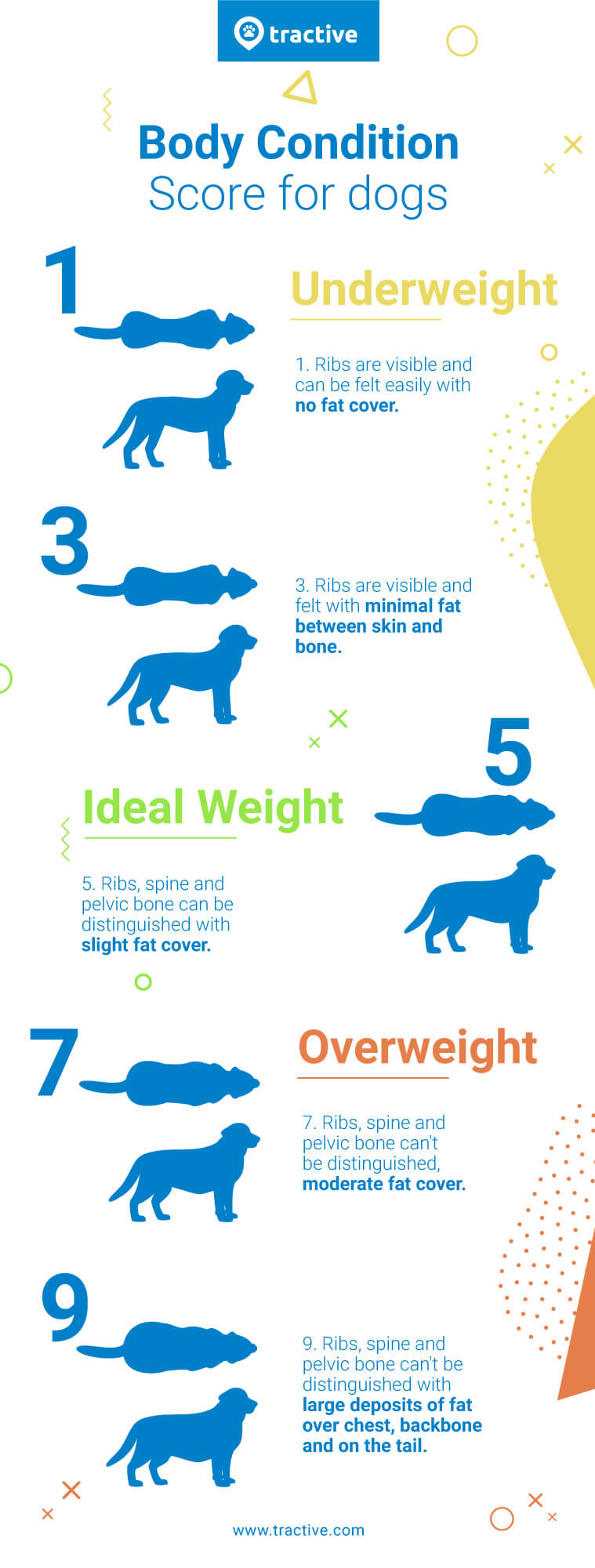
💡And if you’ve got details like your dog’s age, breed, and sex at hand – here’s a dog BMI calculator for you to use. It can help you figure out if your dog’s weight falls in the underweight, normal weight, or overweight category.
Tractive’s BMI Calculator for Dogs
How often should I feed my dog?
For adult dogs, feeding them twice a day — once in the morning and once in the evening — is generally enough. What’s more important is that you’re consistent.
- But if you’ve got a highly active dog at home, they might benefit from three smaller meals.
- Some older, more sedentary dogs might even thrive on one meal per day.
Monitoring your dog’s weight, overall health, and activity level can help determine the best feeding schedule. And of course, check with your vet to ensure you’re feeding your buddy enough to prevent them from scavenging, begging, or sneaking out for any treats.
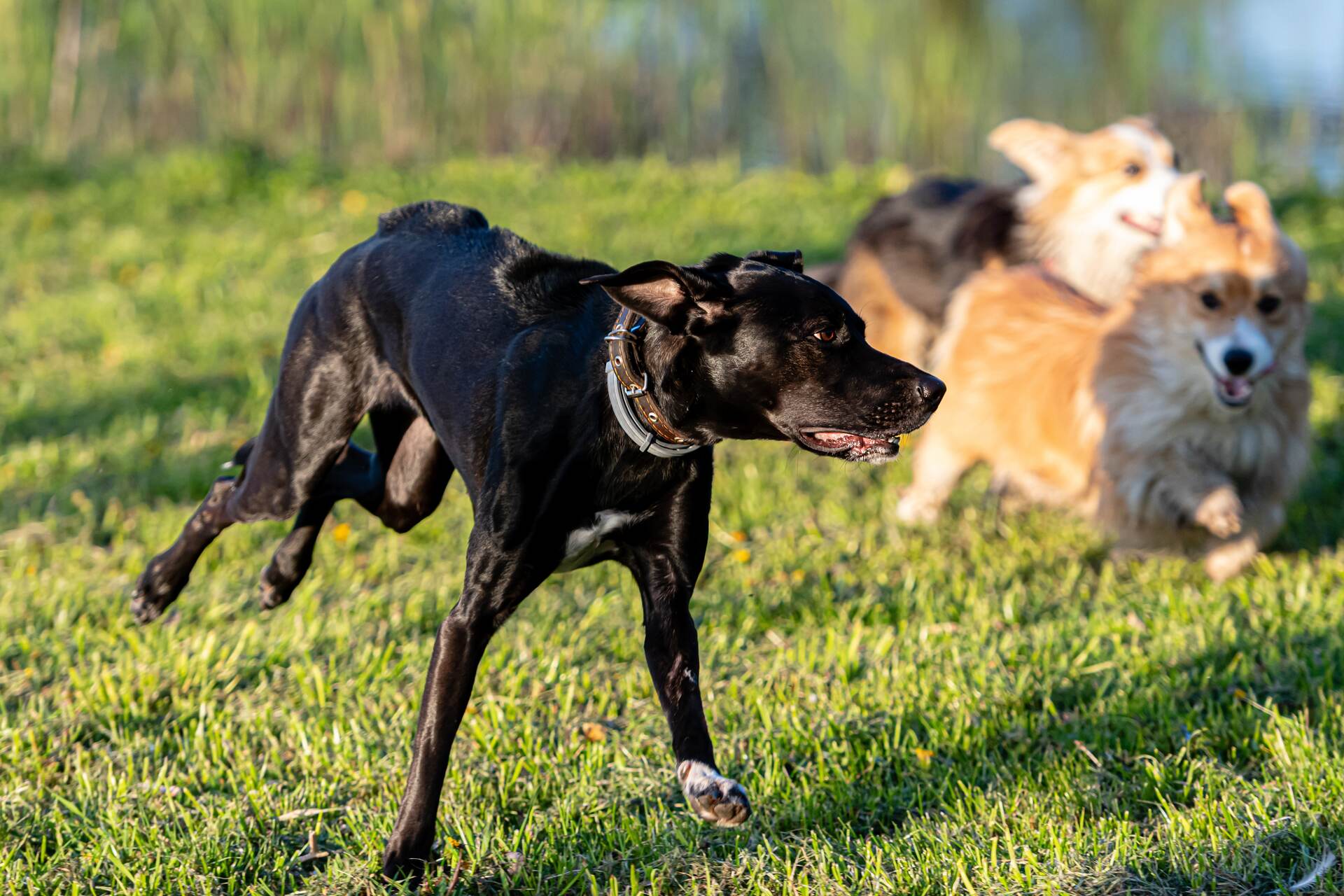
💡Not sure how active your dog is when you’re not around?
Tracking their daily activity can be a great way to check how many calories they’re burning throughout the day – so you can adjust their food accordingly.
Which, if you’ve invested in a Tractive device, has never been easier to do.
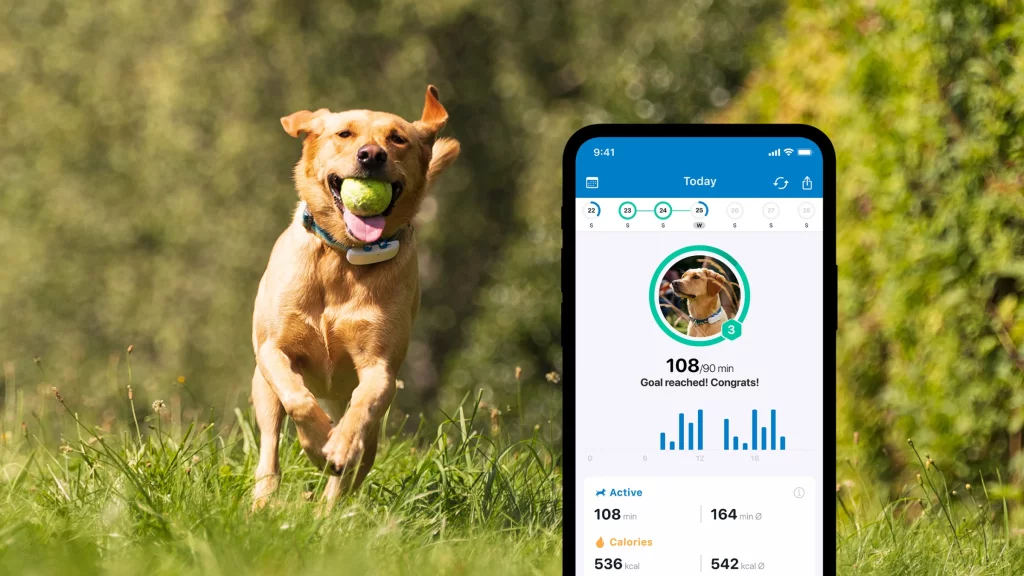
With its built-in motion detector, your trusty Tractive device logs in your dog’s activity throughout the day.
Which, with time, can help you figure out:
- How much activity is normal for your dog, whether from walks, playtime, or just by themselves
- How active your dog is compared to other, similar dogs around the world
- How many calories your dog burns through activity throughout the day
All of which can help you with a weight loss plan – or simply making sure your buddy’s getting the calories and energy they need to stay healthy.
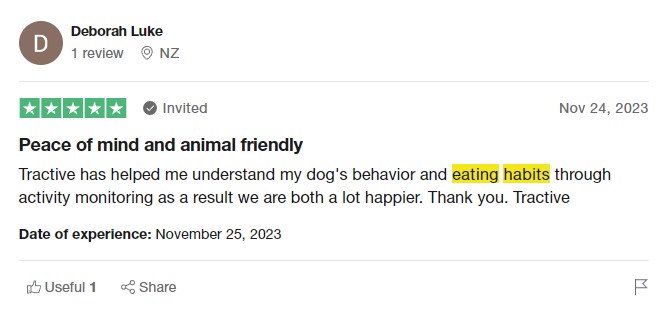
How much should I feed my puppy?
Puppies grow rapidly and need to eat more frequently than adult dogs. Here’s another super rough feeding guide, based on their weight:4
| Puppy weight | Recommended food servings per day |
| up to 12 lbs | 1/3-11/2 cups |
| up to 40 lbs | 1-11/2 cups |
| up to 75 lbs | 11/2-3 cups |
| up to 100 lbs | 2-5 (1/3 cup for every 10 lbs over 100) |
As always, work with your vet to figure out what works best for your little buddy. Make sure to be consistent, so your puppy learns to follow a predictable routine of meal times.
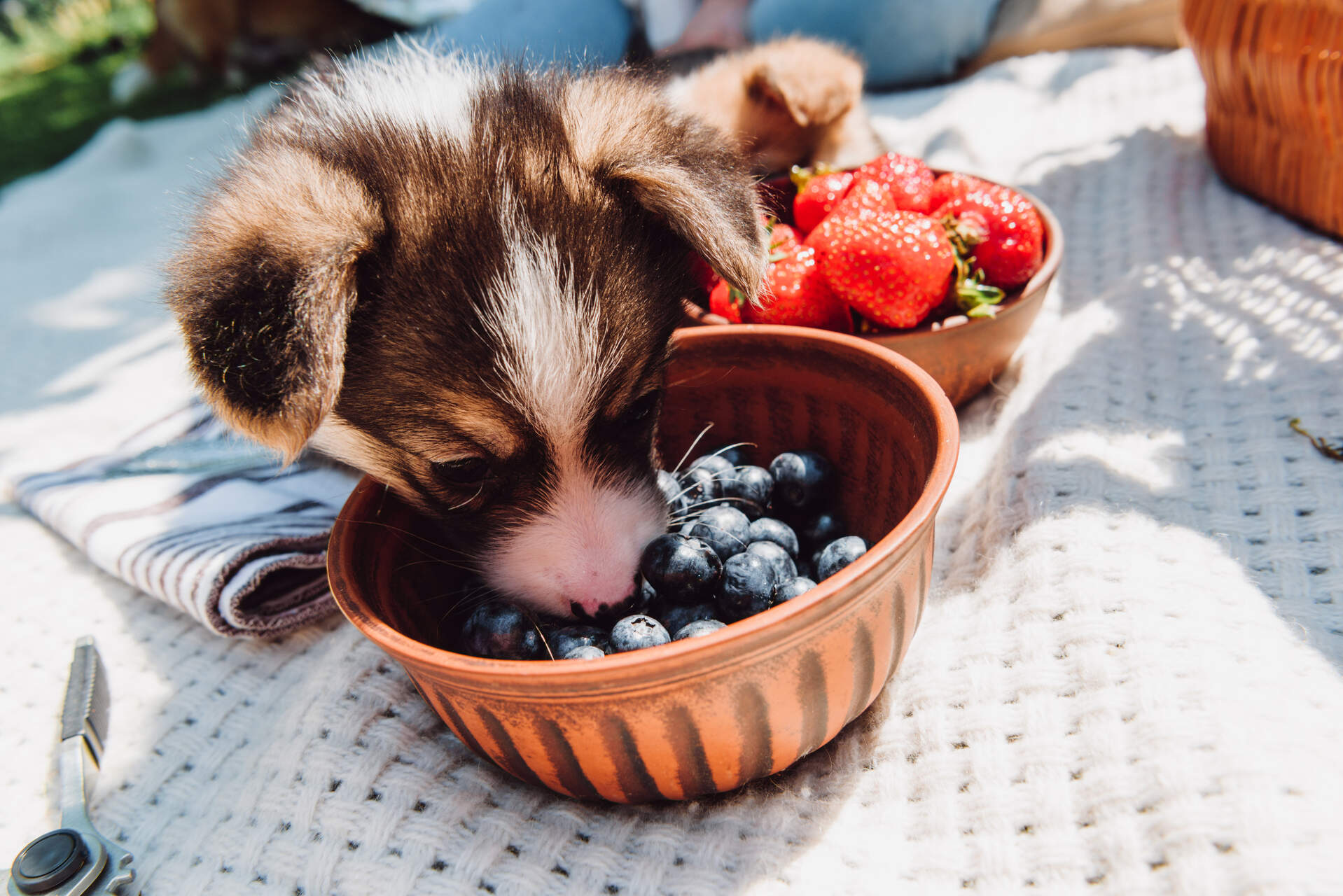
How often should I feed my puppy?
Puppies require more frequent feeding than adult dogs – but as they grow older, it’s fine to gradually wean them off frequent meals to 2 per day. (Like with adult dogs.)
Here’s a general guide to how often you should be feeding them based on their age:
- 8-12 weeks: 4-6 times a day
- 3-6 months: 3-4 times a day
- 6-12 months: 2 times a day (as they slowly transition to “adult dogs”)
I’ve fed my dog enough – but why are they still eating everything in sight?
Now whether you’re feeding them enough or not, it’s still possible your buddy might end up:
- Scavenging any fallen snacks they might come across on your walks together (or from your kitchen)
- Begging for food at house parties, picnics, camps, or even restaurants outdoors
- Sneaking outdoors for a few extra bites, licks, and tastes in specific spots around town (like your local hotdog stand)
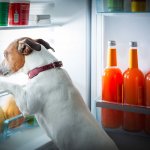
“Dogs are natural scavengers, some breeds more so than others.
Labradors, Beagles and Spaniels are amongst the most prolific food thieves I have encountered on my home visits as a dog behaviourist.“
– Sue Gilmore, MA, FCFBA5
Scavenging is an instinctive behavior – your dog’s wild ancestors did it, and old habits die hard.
⚠️ Meaning, even the most well-fed dog is likely to scavenge or beg for food from others out of:
- Boredom
- Attention-seeking
- …or in some cases, because they actually ARE still hungry (due to some extra exercise)
Which, down the line, can mean your buddy can end up gaining weight – and experiencing weight-related health issues, like obesity and cardiovascular disease.
That’s why it’s not enough to just ensure your buddy’s eating enough. Rather, it’s wise to:
Monitor every morsel your dog eats – both indoors & outdoors
More often than not, your dog is just a Halloween candy or slice of onion away from an emergency trip to the vet’s clinic. Dogs are opportunistic eaters – and they’re likely to grab a bite or lick of pretty much anything they see, both indoors or outdoors.
So make sure to:
- Monitor your dog while you’re, say, busy cooking a meal – and aren’t able to supervise them continuously. Our refrigerators are full of harmless, even healthy ingredients for us…but which may end up fatally poisoning your dog if they grab more than a lick.
- Likewise, never let your dog into the kitchen unsupervised. Get someone to keep them busy while you’re cooking – either with some playtime or a Youtube video, if necessary.
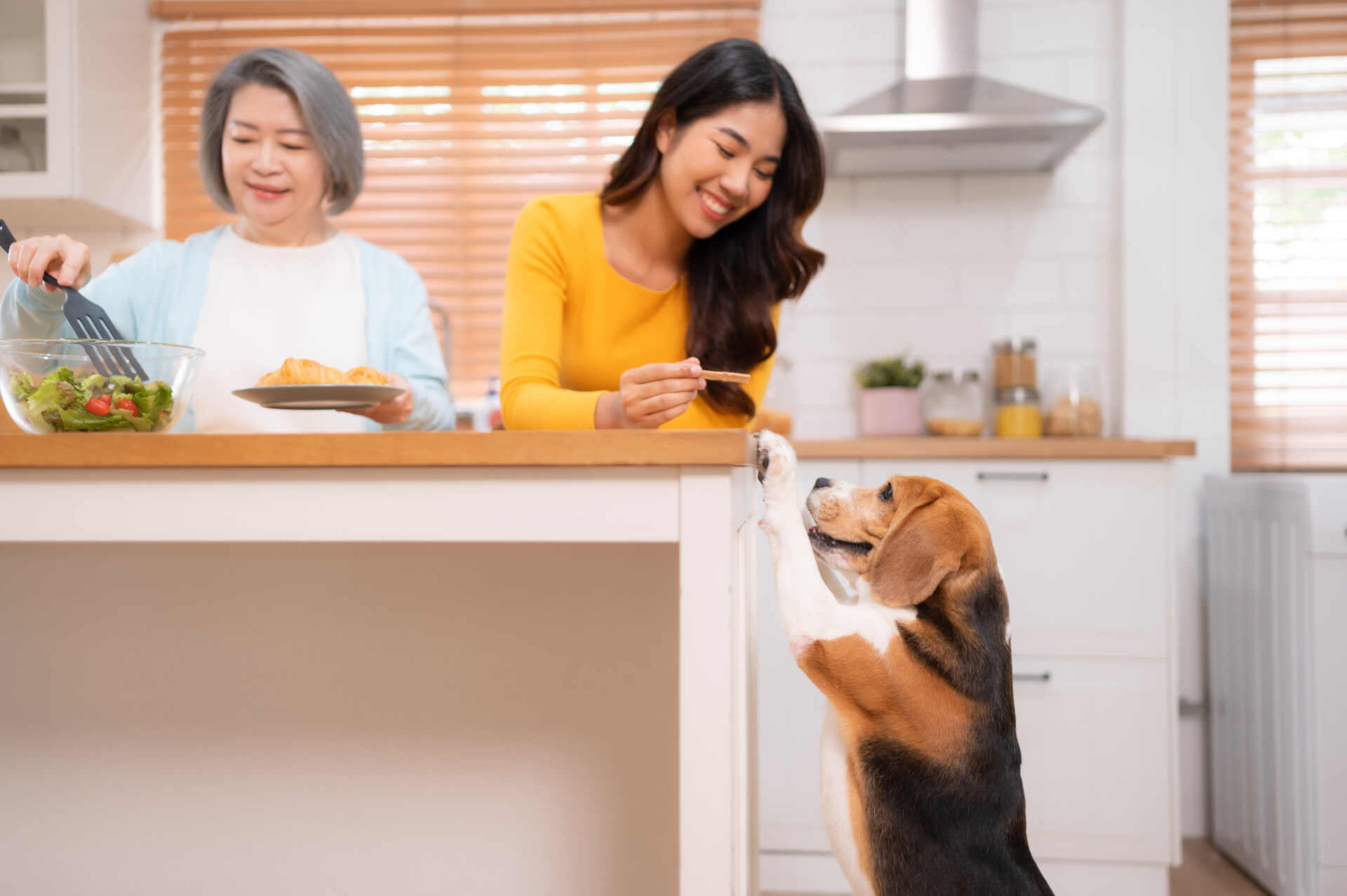
- Keep your dog’s eating area separate from the “human foods” table. This can reduce their temptation to steal or beg for some extra treats.
- Watch out for fallen foods, candy wrappers, and other “forbidden snacks” on forest trails, pavements, and wherever you’re both walking outdoors.
Read more: What Can Dogs Not Eat? 15 Foods Poisonous To Dogs
Set some firm boundaries with anyone else interacting with your dog
Besides you, your housemates, loved ones, neighbors, and everyone else meeting your dog needs to be on the same page as you. Meaning only consistent mealtimes – and no treats or snacks outside of them! (Nope, not even if your dog begs or pulls the old puppy eyes trick.)
Which is where it makes sense to gently remind any guests, family members, and even your neighbors of the “no treats” rule. So you can avoid one of your kids palming off some unwanted veggies to your dog’s plate – or someone feeding them potentially toxic entirely by accident.
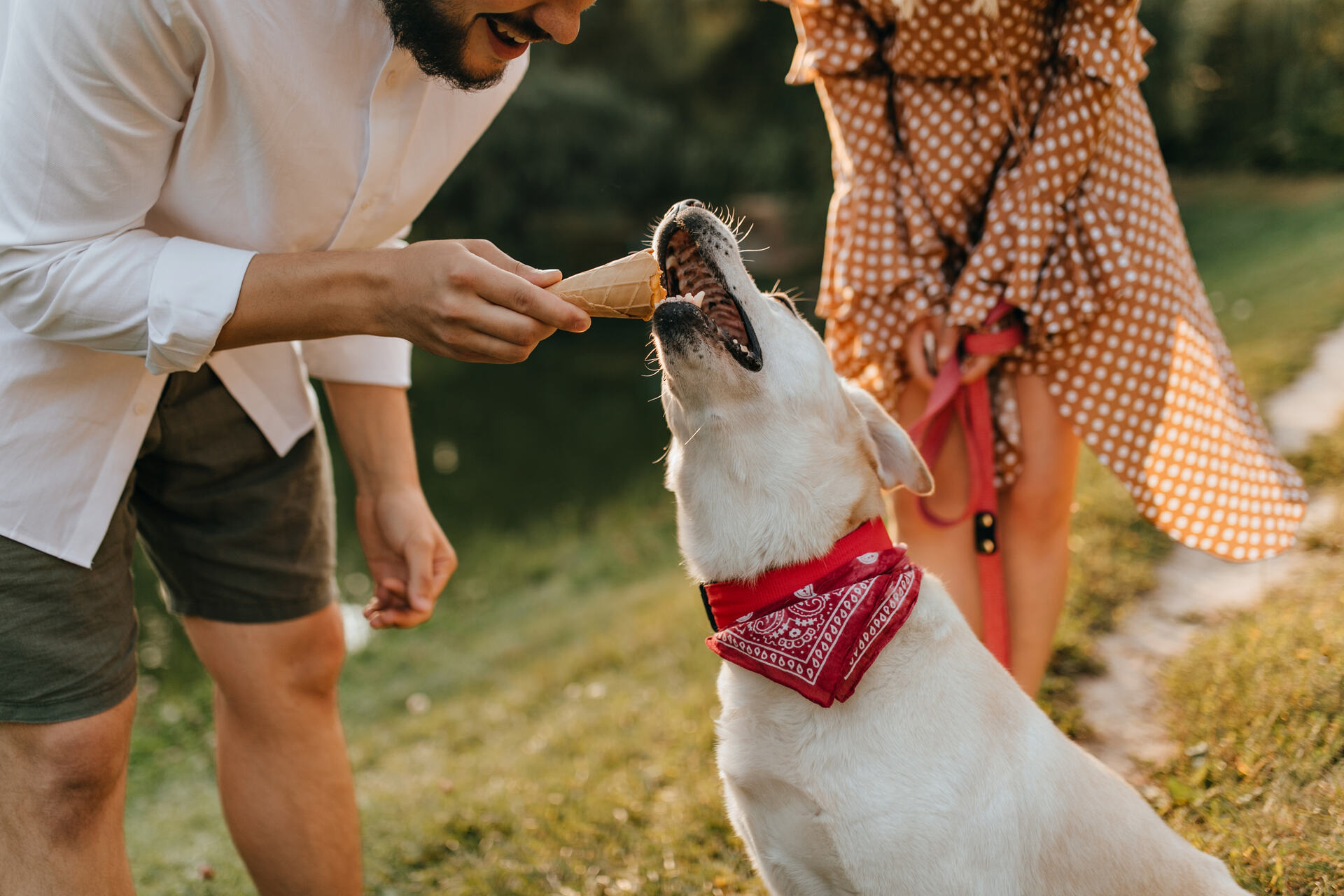
💡By “no treats”, we do mean “no extra treats.”
Meaning, any treats you DO give your dog should ideally be covered within their daily calories. (And account for no more than 10% of them.)
Figure out where your dog likes to hang out around town
Whether it’s at the kebab stand by the street or your neighbors’ backyards – figuring out your dog’s favorite spots can help you figure out if:
- They’re primarily hanging out near “feeding spots” – like any local campsites or restaurants
- Whether they’re heading to spots they might pick up something infectious, smelly, or eat something toxic
- Whether they’re heading too far from safety – where they might end up getting lost
Which you could do by, well, hovering over your dog 24/7 – and which isn’t sustainable in the long run. (You do have work, chores, and a life, after all.)
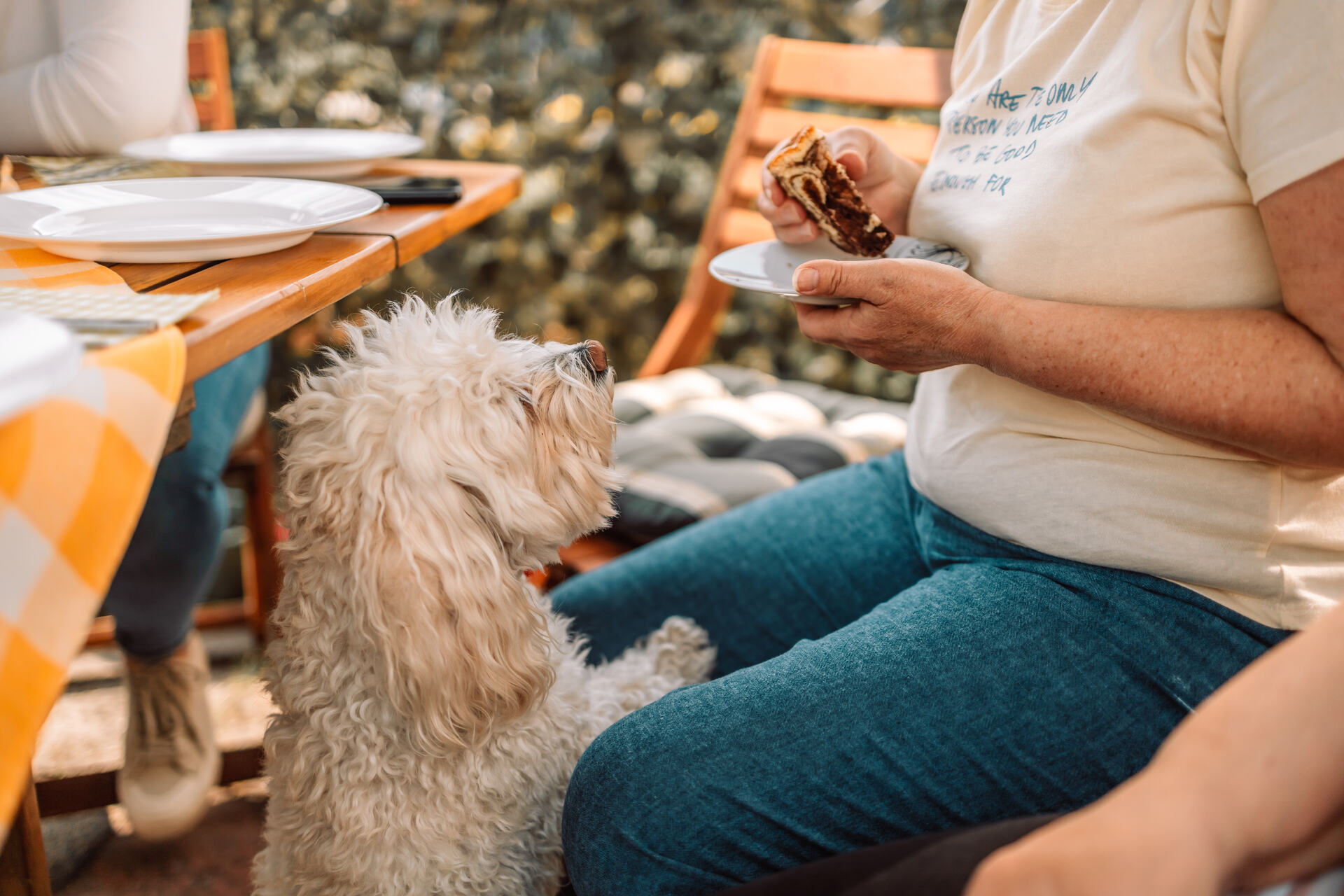
💡 Or you could do as dog parents around the world – just like you – and strap a GPS tracker to your dog’s collar.
Ideally, one that comes with a 24-hour Heat Map and Location History – pictured below. (Or 365 days on a Premium subscription.)

Because besides Activity Tracking, your trusty Tractive GPS ensures you have a sky full of satellites helping you track your dog:
- In real-time,
- Over an unlimited range,
- While on vacation – or 175 countries if you’re on a Premium subscription
All with just a glance at your phone.
Which, combined with your dog’s Location History, means you now know where to look first in case your buddy goes missing.
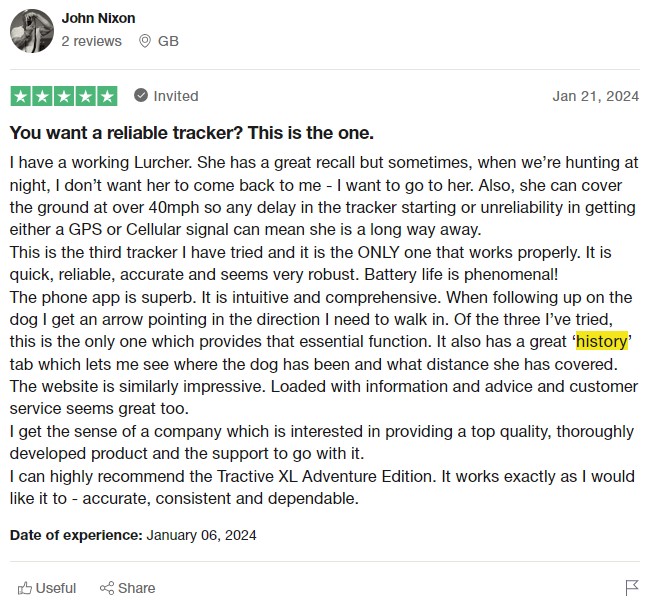
Never under- or overfeed your buddy again – and keep them in shape for life
Figuring out the right balance to feed your dog can be a challenge. You have to keep in mind factors like their age, size, breed, activity level, whether they’ve been neutered or not, and any existing health conditions. But with a little experimenting and consistency, you’ll set your buddy up for a healthy, happy life by your side for good.
In general, most adult dogs do fine with 2 meals a day – depending on their weight:
| How much your dog weighs | Recommended food serving |
| 3-6 lbs | 1/3 to 1/2 cup of food per serving |
| 10-20 lbs | 3/4 to 11/3 cup of food per serving |
| 30-50 lbs | 13/4 to 22/3 cup of food per serving |
| 60-100 lbs | 3 to 41/2 cup of food per serving |
| 100+ lbs | 41/2 plus 1/4 cup for every extra 10 lbs |
Puppies, on the other hand, could benefit from more frequent meals as they grow – 4-6 initially, but tapering off to 2 per day.
| Puppy weight | Recommended food servings per day |
| up to 12 lbs | 1/3-11/2 cups |
| up to 40 lbs | 1-11/2 cups |
| up to 75 lbs | 11/2-3 cups |
| up to 100 lbs | 2-5 (1/3 cup for every 10 lbs over 100) |
💡Figuring out your dog’s body condition score, as well as how active they are, can help you figure out how much food to give them.
Besides, it’s always a good idea to check with your vet to ensure you’re giving your buddy the energy they need to stay healthy.
I’ve fed my dog – but they still keep scavenging or begging for food!
Scavenging is an instinctive behavior for dogs, while begging for food is a learned behavior. Both of which can lead to your dog overeating – and potentially gaining more weight than they should, with time. (Opening up the risk for a host of healthy issues down the line.)
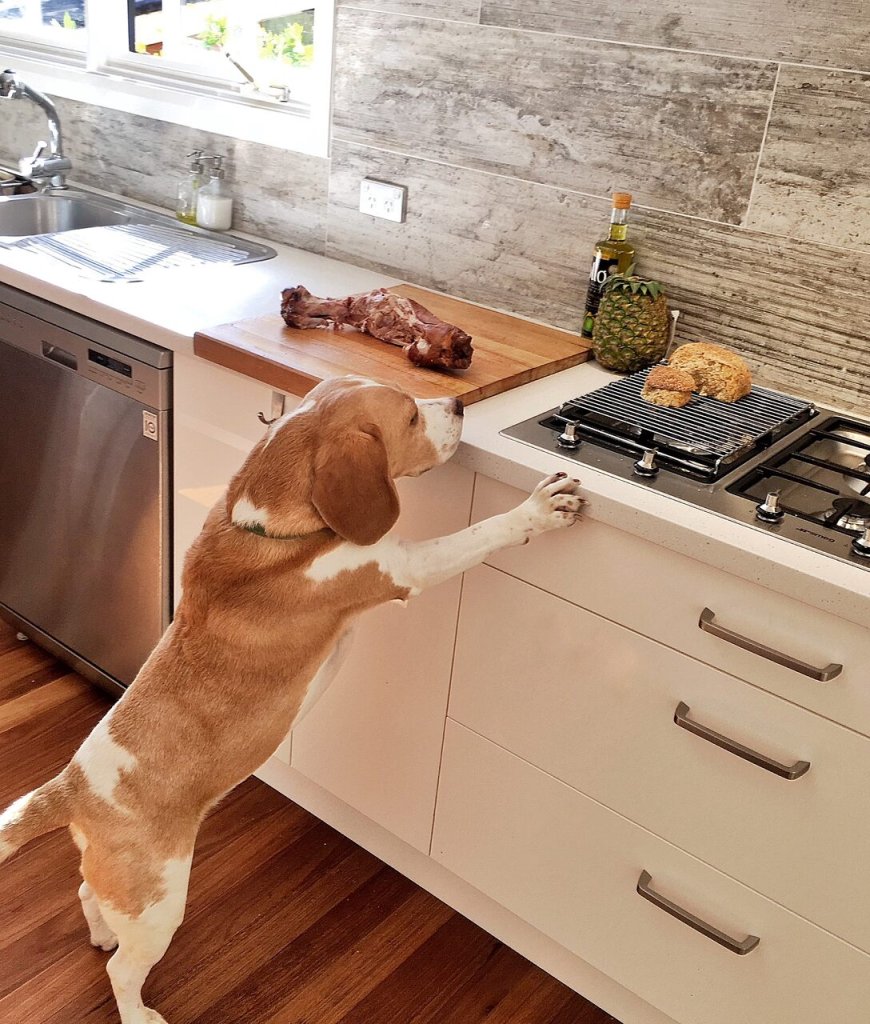
So you’ll find it helpful to:
- Be extra mindful of what your dog’s eating – both from your kitchen and while out on walks. Even a bite, lick, or taste can prove fatal if it’s something toxic to dogs!
- Be firm with friends, family, and neighbors about the “no extra treats” policy, no matter how much your dog begs.
- Keep track of your dog’s outdoor wanderings, especially any spots around town they might be getting some extra “snacks” and treats.
💡And if you’ve invested in a Tractive device, just a glance at your phone means you’ve got:
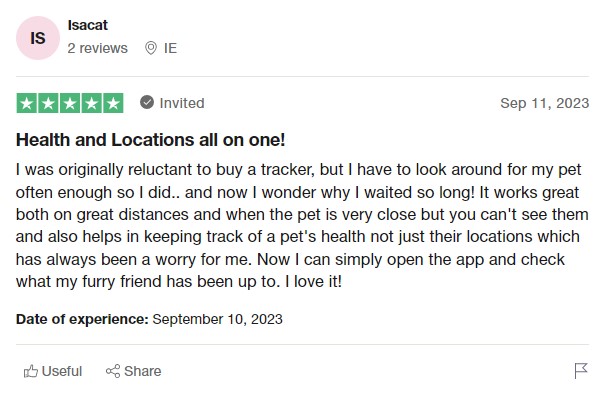
Plus, if you’re looking to help your buddy lose a bit of weight…
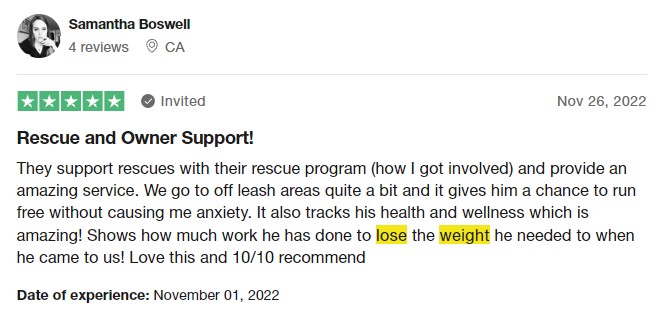
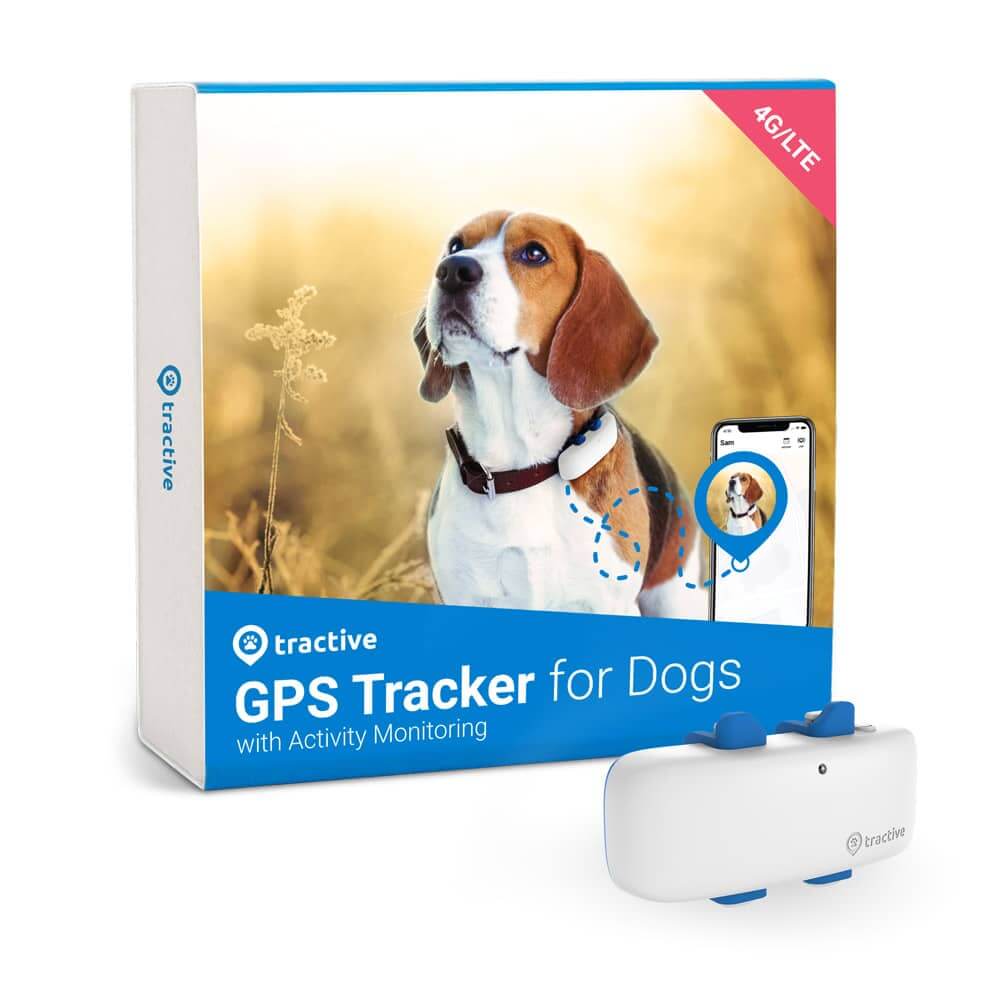
Always know where your dog is
Follow every step in real-time with unlimited range. Get alerts if they wander too far. Keep them happy & healthy with Wellness Monitoring. And let others – like walkers or sitters – keep an eye on your dog too.
Want an expert opinion on how much food you should give your dog? Here’s Dr. Joe Spoo sharing his take:
And if you’ve liked this post, share it with a friend or a loved one – and let’s help build a safer, kinder world for our furry friends together.
